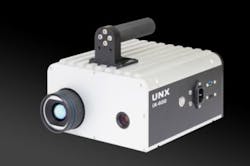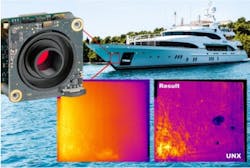Non-Destructive Testing of Composite Materials
The iX-600 portable inspection system from UNX Technologies provides contactless inspection of multilayer composites, even for large surfaces. It uses image processing to detect weak points that are invisible to the human eye. In addition to a thermal imaging camera, a uEye board level camera with autofocus from IDS Imaging Development Systems is used.
Especially, in maritime applications the demand for composites is continuously increasing. In addition to floor elements, side walls, ceiling paneling or doors, also toilet compartments and separation units made of composite materials can be supplied. Moreover, load-bearing parts such as floors, walls or roof panels are possible and provide considerable weight savings. A classic example of a composite material used here is CFRP - carbon fiber reinforced plastic. It has a high stiffness and is very light at the same time. Or also GFRP - fiberglass-reinforced plastic, a material made of plastic and fiberglass. It is cost-effective and yet very high quality.
With such lightweight construction materials, the individual components are not combined into a single material, but exist virtually side by side. Therefore, damage such as bubbles, pores, foreign inclusions and delamination (peeling off of layers) can occur due to manufacturing processes. Even during operation, i.e. while the vehicle is moving, the strength of the material can be impaired, for example by an impact event. An impact against a composite panel can leave no visible damage on the outside.
Inside, however, it will still lead to a reduction in compressive strength. Regular testing of the materials is therefore not only sensible but also vital for safety. Yacht manufacturers usually use the ultrasonic or impact-echo method to detect defects. This is based on the use of sound waves. It was developed in the 1980s for testing reinforced concrete components and is currently widely used. However, this process requires contact between the parts and is time consuming.
The portable inspection system iX-600 enables a non-contact and therefore guaranteed non-destructive inspection (NDI - Non-Destructive-Inspection) of composite materials. Testing can be carried out with regard to detachment, delamination or porosity. The material properties are analyzed beneath the surface, and thus defects in the interior of the material are detected. The system also captures large inspection areas or curved structures effortlessly - without requiring a material sample in advance. For composite materials with multilayer structures, the iX-600 can also be used in addition to the manual sequential ultrasonic scanning described above to replace point information with area information.
The fault location can be determined quickly and precisely. In addition to the infrared thermal image for evaluating the general temperature distribution on the test surface, the UNX system receives parallel image information from the integrated industrial camera. Thus it determines the exact defect status of the material. The decisive factor is therefore the combination of an infrared camera with a board level camera with autofocus from IDS, paired with a built-in industrial computer with a 7-inch touch screen and the associated software. The instrument, patented in Taiwan, is mobile and does not require an additional external computer.
Demo recording
Using the example of the outer skin of a motor yacht, the procedure can be explained in simple terms. The board-level camera records the current image of the area to be inspected exactly parallel to the thermal imaging camera during the inspection. With the help of image processing technology, the system can quickly detect defective areas by analysing and matching the image data and display their relative position. All measurement results are clearly displayed and documented in the image. The delamination defect for example (green frame in the picture) can then be easily located for repair.
The uEye LE AF USB 3.1 Gen 1 boardlevel camera from IDS is suitable for the use and control of liquid lenses and offers a practical autofocus function. This allows for optimally focused images at variable object distances. The automatic system is based on an "active" liquid lens control and can be easily triggered by software. Depending on the application, the autofocus can be individually configured and ensures perfectly sharp images in no time at all. UNX has specifically chosen the model UI-3881LE AF with S-Mount lens mount. The camera is equipped with the 1/1.8" rolling shutter CMOS sensor IMX178 from the Sony STARVIS series and enables a resolution of 6.41 MPixel (3088 x 2076 px) at a frame rate of up to 58 fps. In addition to its high resolution, the sensor scores with speed and sensitivity, so that excellent images are achieved even under low-light conditions.
The UI-3881LE AF has a twist-proof USB Type-C connector as well as USB power delivery and can be easily integrated into embedded systems. Due to its compact design (36 x 36 x 20 mm) it can be installed in the smallest space and is perfectly suited for classic machine vision applications and tasks in the fields of microscopy, medical technology, metrology and traffic monitoring. It is also predestined for installation in small industrial devices, such as the iX-600 from UNX Technologies.
The Taiwanese company uses the IDS Software Development Kit to integrate the camera. IDS Software Suite is a free software package that is exactly the same for uEye industrial cameras (model designation "UI") and can easily handle a mixed operation of USB 2.0, USB 3.0, and GigE uEye cameras. In addition to the camera drivers, it contains sample programs in various programming languages such as .NET.


